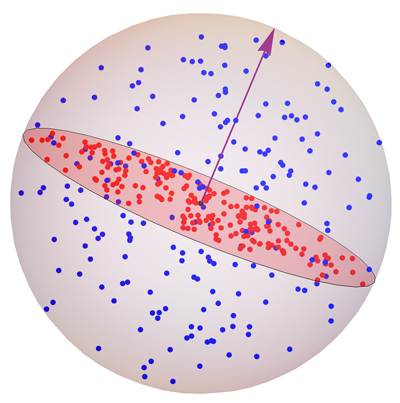Let $P$ be a set of $n$ random points uniformly distributed inside a unit-radius sphere centered on the origin. Orthogonally project $P$ to a random plane through the origin; call the projected points $P_{\bot}$. Let $A$ be the distance matrix for $P$, and $B$ the distance matrix for $P_{\bot}$, where an $n \times n$ distance matrix records the Euclidean distance between pairs of points. So these matrices are symmetric across a diagonal of zeros.
Finally, define the distance between matrices $A$ and $B$ as $$ d(A, B) = \frac{\sqrt{\sum_{i=1}^n \sum_{j=1}^n (a_{ij} - b_{ij})^2}}{n} \;. $$ (This matrix distance likely has a name, but I don't know it.)
Simulations suggest that $d(A,B)$ is close to $\frac{1}{3}$, independent of $n$. For example, for $n{=}200$, $50$ random trials led to $0.332$.
Q1. Is it true $d(A,B) = \frac{1}{3}$ exactly?
Q2. If so, is there some intuitive way to see this without calculation?

$n=200$ points $P$ (blue) in $\mathbb{R}^3$ projected to $P_{\bot}$ (red).
Update 1. Following @Henry.L's suggestion in the comments, for a sphere of radius $r{=}2$, I find $d(A,B) \approx \frac{2}{3}$. This suggests the matrix distance might be $\frac{r}{3}$.
Update 2. A histogram of $d(A,B)$ for $n{=}100$, $5000$ random trials:

